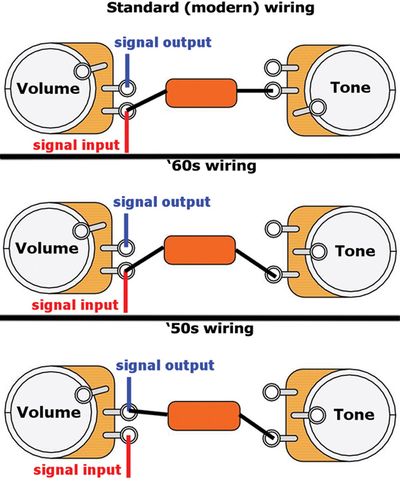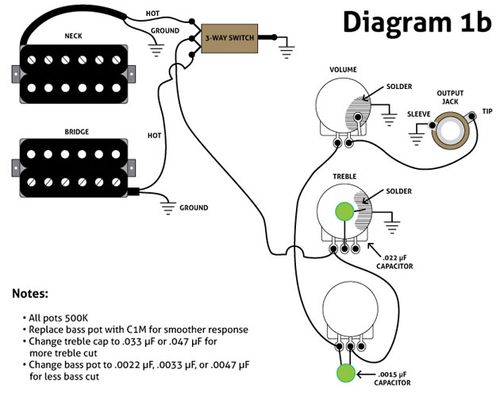gdvsbp
TDPRI Member
Hi, folks. I've been looking around for this info for a while, and I guess the fact is I just don't have the electrical knowledge that I need to answer it myself. That said, I'm hoping some of you might be able to point out what I misunderstand here, and that I can come out of it with a little more knowledge under my belt.
Background: I have a Squier tele I'm looking to add a version of a PTB (passive treble and bass) control to as part of a full rewiring. I also intended to use '50s wiring on the guitar, which would have the tone control branching off from the output lug of the volume pot.
The question: When I look up schematics for PTB circuits for 3-knob guitars, the order of components is:
So here's what I am: I'd like to keep my tone (or treble roll-off, if I'm using PTB parlance) in the '50s position (parallel with output, post-volume), because the tone loss that rolling down volume brings on a pre-volume tone pot has been the reason I've avoided the volume control on guitar for my whole life. So that's important to me (and I so far haven't loved treble-bleed circuits as a solution either). But, I also understand that the volume pot's position after the bass-cut is essential to the bass-cut control actually doing something (series... resistance? capacitance? I don't know). Would a post-volume tone pot limit the effectiveness of the bass-cut? Should I just plan for my volume/treble/bass controls to be "very interactive," but otherwise expect things to work?
My guess is the answer is "very interactive, but functional." I really hope I'm right.
Anyway, please let me know if I'm wrong, and if so why I'm wrong. Or maybe even why I'm right?
References:
Background: I have a Squier tele I'm looking to add a version of a PTB (passive treble and bass) control to as part of a full rewiring. I also intended to use '50s wiring on the guitar, which would have the tone control branching off from the output lug of the volume pot.
The question: When I look up schematics for PTB circuits for 3-knob guitars, the order of components is:
- Pickups
- Switch
- Treble roll-off (usually a pot branching off the circuit, bleeding treble to ground in parallel as resistance accumulates)
- Bass roll-off (usually a pot wired pass-thru, adding some sort of series resistance)
- Volume pot (nothing special, but apparently needed after bass roll-off to make that control effective)
- Output
- Pickups
- Switch
- Volume pot
- Tone pot (branching off volume pot output lug, bleeding treble to ground)
- Output
So here's what I am: I'd like to keep my tone (or treble roll-off, if I'm using PTB parlance) in the '50s position (parallel with output, post-volume), because the tone loss that rolling down volume brings on a pre-volume tone pot has been the reason I've avoided the volume control on guitar for my whole life. So that's important to me (and I so far haven't loved treble-bleed circuits as a solution either). But, I also understand that the volume pot's position after the bass-cut is essential to the bass-cut control actually doing something (series... resistance? capacitance? I don't know). Would a post-volume tone pot limit the effectiveness of the bass-cut? Should I just plan for my volume/treble/bass controls to be "very interactive," but otherwise expect things to work?
My guess is the answer is "very interactive, but functional." I really hope I'm right.
Anyway, please let me know if I'm wrong, and if so why I'm wrong. Or maybe even why I'm right?
References:
- 50s wiring

- PTB circuit

